Outline of a program 'f90_fem_ini4.f90'
- This is a program for 2D-tunnel excavation analysis. Elastic and small displacement problems can be treated.
- 4 node isoparametric element with 4 Gauss points is used as a 4 node element. 1 node has 2 degrees of freedom in horizontal direction and vertical direction.
- This program can do plane stress analysis or plane strain analysis.
- In coordinate system, x-direction is defined as right-direction, y-direction is defined as upward direction and counterclockwise direction is defined as positive in rotation.
- Simultaneous linear equations are solved using Cholesky method for banded matrix.
- Input file name can be defined arbitrarily with the format of 'csv' and Output file format is blank selected value.
- Used language for program is 'Fortran 90' and used compiler is 'GNU gfortran.'
| Workable condition | |
|---|---|
| Item | Description |
| Element | Quadrilateral element |
| Load | Equivalent excavation loads will be calculated automatically |
| Displacement | Specify the nodes and displacements at the nodes. Any values can be applied including zero |
| Initial stress | Initial stress in the ground shall be specified for calculation |
Steps for calculation
| (1) Input model caracteristics |
| (2) Set initial stresses |
| (3) Calculate equivalent excavation force |
| (4) Calculate displacements and stresses by loading equivalent excavation forcr |
Commands for calculation
gfortran -o f90_fem_ini4 f90_fem_ini4.f90 ./f90_fem_ini4 gamma sig0 r fnameR.csv fnameW.prn
| f90_fem_ini4 | Program for execution |
| gamma | Unit weight of ground material |
| sig0 | Initial vertical stress at y=0 on the model |
| r | Lateral pressure ratio (lateral stress / vertical stress) |
| fnameR.csv | Input file (csv format) |
| fnameW.prn | Output file (prn format: space separated values) |
Format of input data file ('csv' format)
Comment # Comments
NODT,NELT,MATEL,KOX,KOY,NF,NSTRES,IPR # Basic values for analysis
t,Em,po,c,phi,sigt # material properties
....(1 to MATEL).... #
node-1,node-2,node-3,node-4,matno # Element connectivity, material set number
....(1 to NELT).... #
x,y # Node coordinates
....(1 to NODT).... #
nokx,rdisx # Restricted node number and displacement in x-direction
....(1 to KOX).... # (Omit data input if KOX=0)
noky,rdisy # Restricted node number and displacement in y-direction
....(1 to KOY).... # (Omit data input if KOY=0)
nonf # loaded node number
....(1 to NF).... # (Omit data input if NF=0)
| nod | : Number of nodes of each element (3 or 4) | t | : Thickness of element |
| NODT | : Number of nodes | Em | : Elastic modulus of element |
| NELT | : Number of elements | po | : Poisson's ratio of element |
| MATEL | : Number of material set | c | : Pure shearing strength of element |
| KOX | : Number of restricted nodes in x-direction | phi | : Internal friction angle of element |
| KOY | : Number of restricted nodes in y-direction | sigt | : Tensile strength of element |
| NF | : Number of loaded nodes | matno | : Material set number |
| NSTRES | : 0: plane strain, 1: plane stress | ||
| IPR | : Output format of stresses (0 or 1) | ||
| (0: All Gauss points, 1: average) |
Notice
- Restricted node means the node which has known (given) displacement. As a known (given) value of nodal displacement, any value can be given including zero for a restricted node.
Format of output file ('prn' format)
Comment
nod NODT NELT MATEL KOX KOY NF NSTRES IPR
(Each value for above item)
*node characteristics
node x y fx fy fix-x fix-y rdis-x rdis-y
node : Number of nodes
x,y : Coordinates of x & y-direction
fx,fy : Loads of x & y-direction
fix-x : x-direction restricted condition (1: restricted, 0: not restricted)
fix-y : y-direction restricted condition (1: restricted, 0: not restricted)
rdis-x : x-direction specified displacement
rdis-y : y-direction specified displacement
.....(1 to NODT).....
*element characteristics
element node-1 node-2 node-3 node-4 E po t chs phi sigt matno
element : Element number
node-1,node-2,node-3,node-4 : Element-nodes relationship
E : Elastic modulus of element
po : Poisson's ratio of element
t : Thickness of element
chs : Pure shearing strength of element
phi : Internal friction angle of element
sigt : Tensile stress of element
matno : material set number
.....(1 to NELT).....
*displacements and forces
node coord-x coord-y dis-x dis-y reac-x reac-y ftvec-x ftvec-y
node : Node number
coord-x,coord,y : x & y-coordinates
dist-x,dist-y : x & y-direction displacements
reac-x,reac-y : These values shall be zero.
ftvec-x,ftvec-y : x & y-direction loaded forces
.....(1 to NODT).....
*stresses
element kk coord-x coord-y sig-x sig-y tau-xy ps1 ps2 ang SF matno
element : Element number
kk : Gauss point number (IPR=0: 1 to 4, IPR=1: Average stress of element)
coord-x,coord-y : Coordinates of calculation point of stresses
sig-x,sig-y,tau-xy : Normal stresses in x & y-direction, shearing stress
ps1,ps2,ang : 1st & 2nd principal stresses, principal direction (degree)
SF : Point safety factor
matno : Material set number
.....(1 to NELT, depending on the value of IPR).....
#,Summary
#,NELT=(Number of elements) NODT=(Number of nodes) nt=(nt) mm=(mm) ib=(ib)
#,ps1_range, (ps1_min), (ps1_max)
#,ps2_range, (ps2_min), (ps2_max)
#,sf_range, (sf_min) , (sf_max)
#,dis_max, (dis_max)
nt : Total degrees of freedom of FE equation
mm : Dimension of reduced FE equation
ib : band width of reduced FE equation
Sample drawings
Mesh by GMT
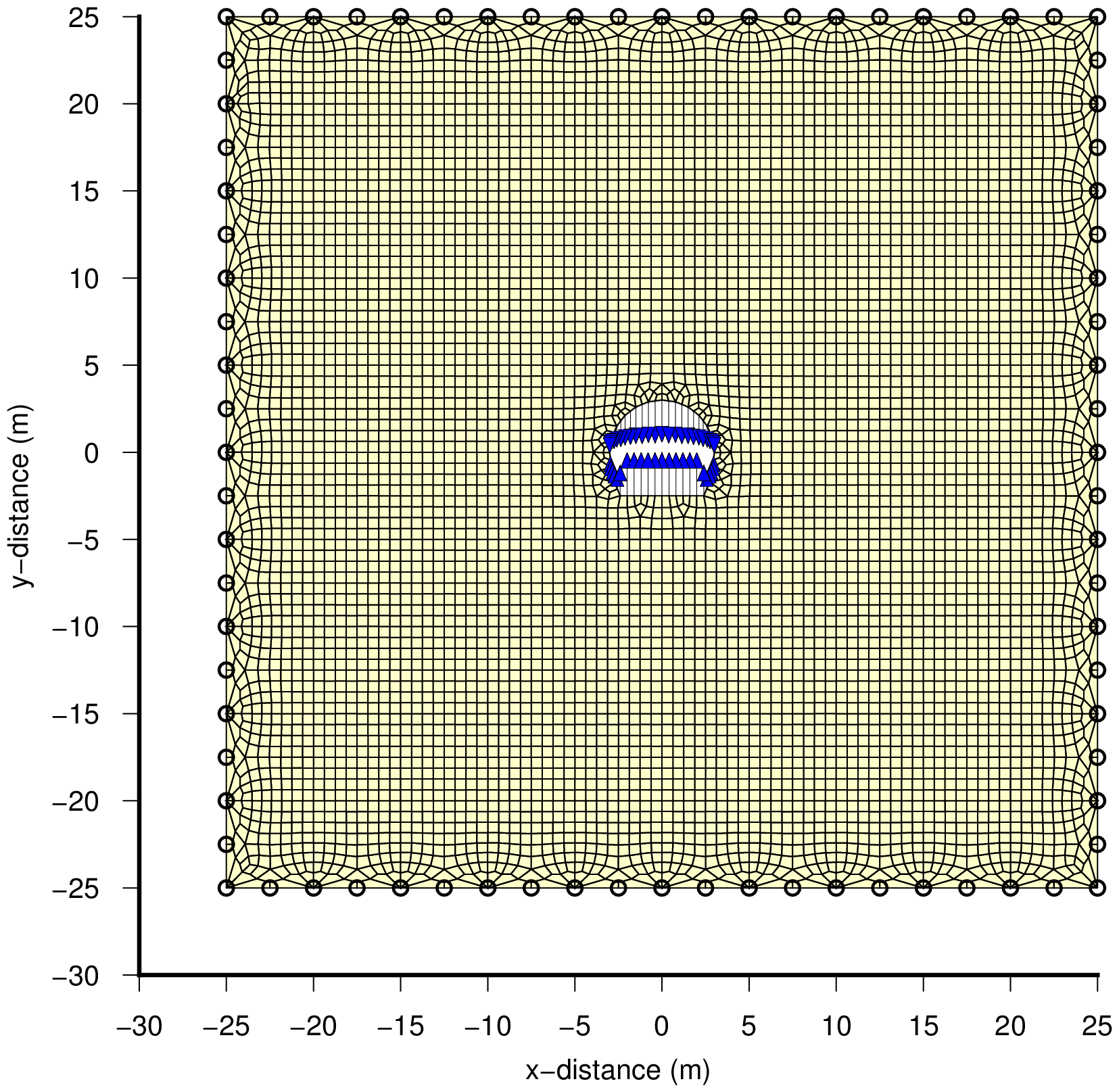 |
 |
| fig_gmt_mesh.png | fig_gmt_disp.png |
|---|
Contours by GMT (unit of stresses: tf/m$^2$)
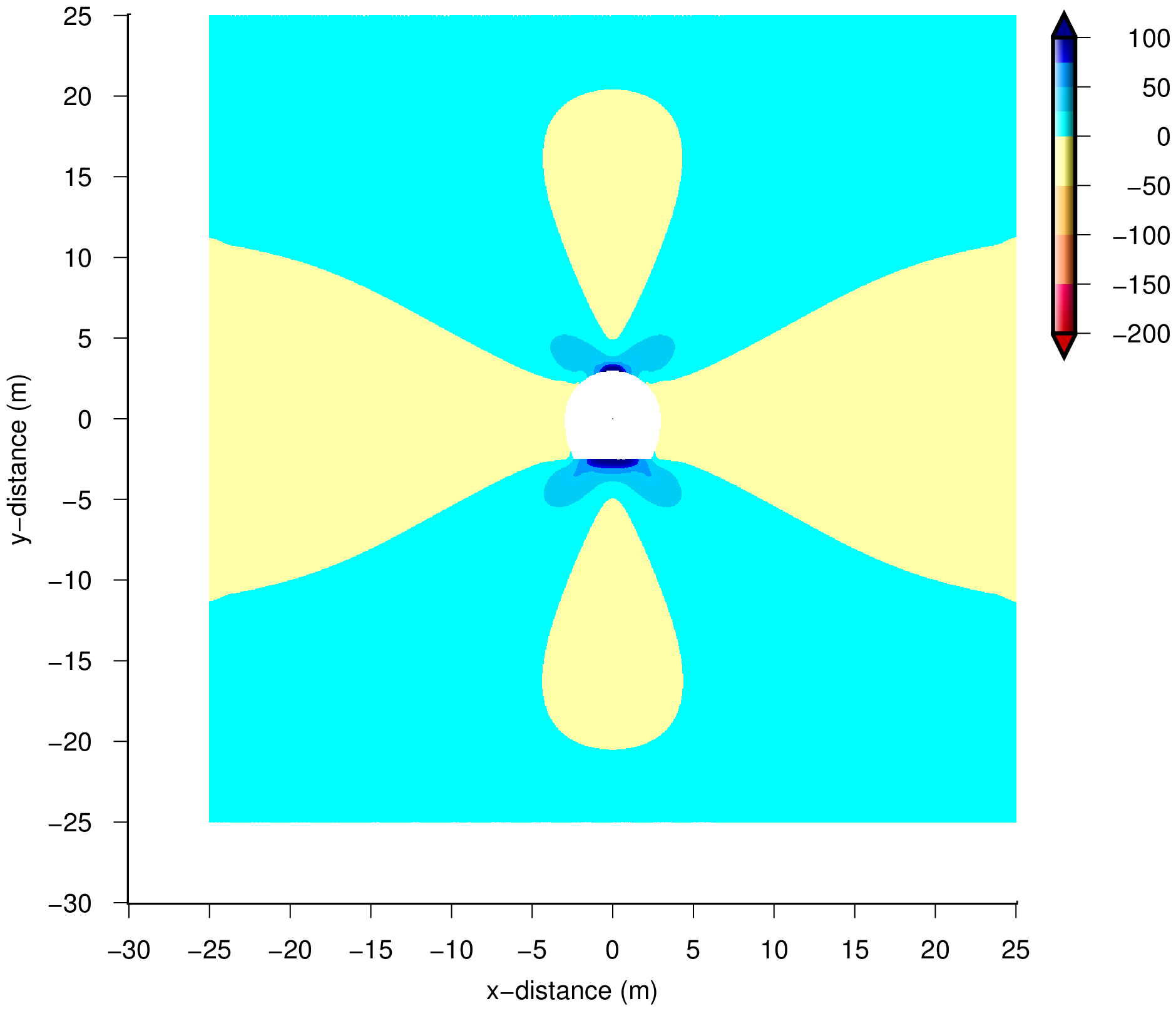 |
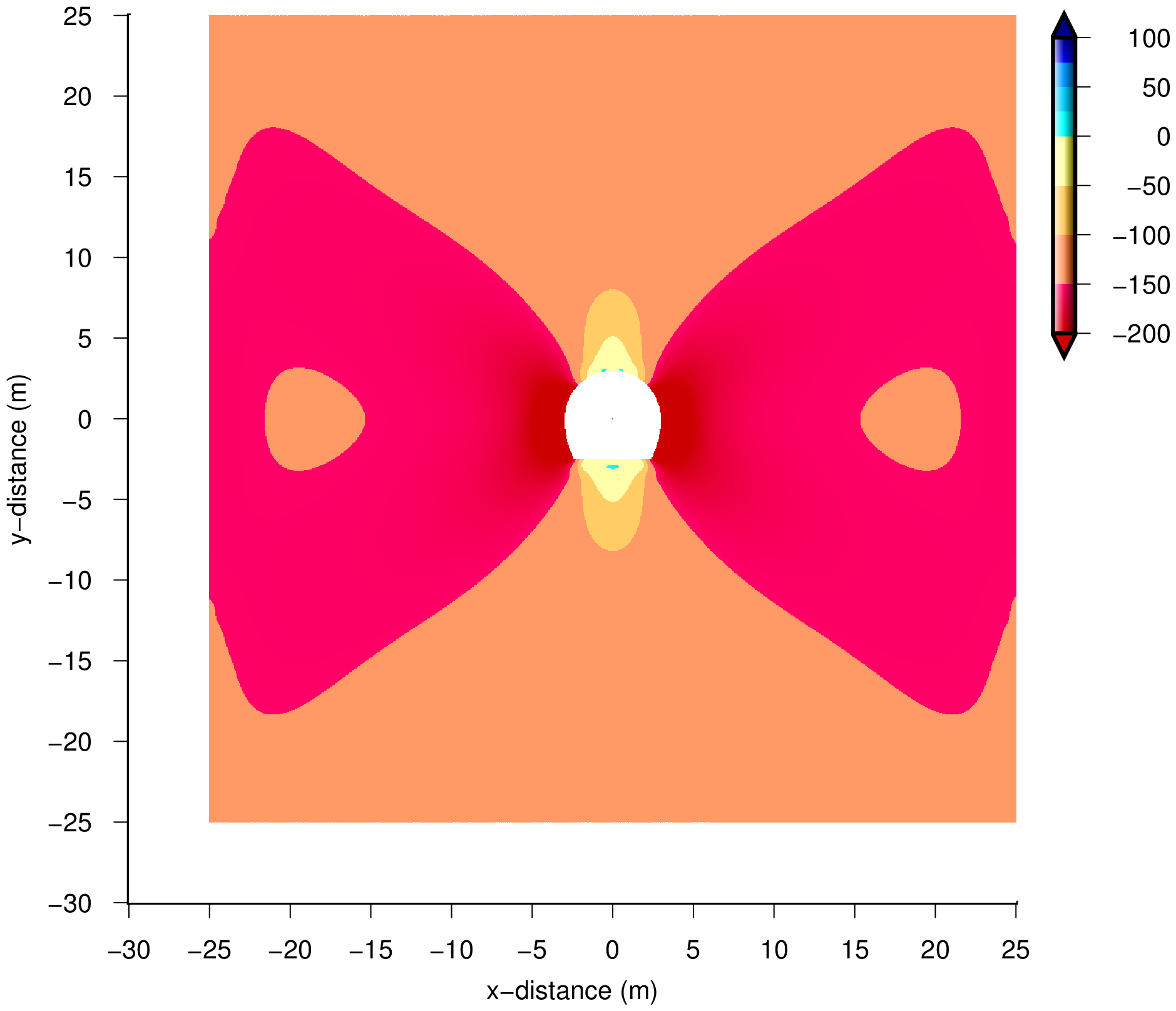 |
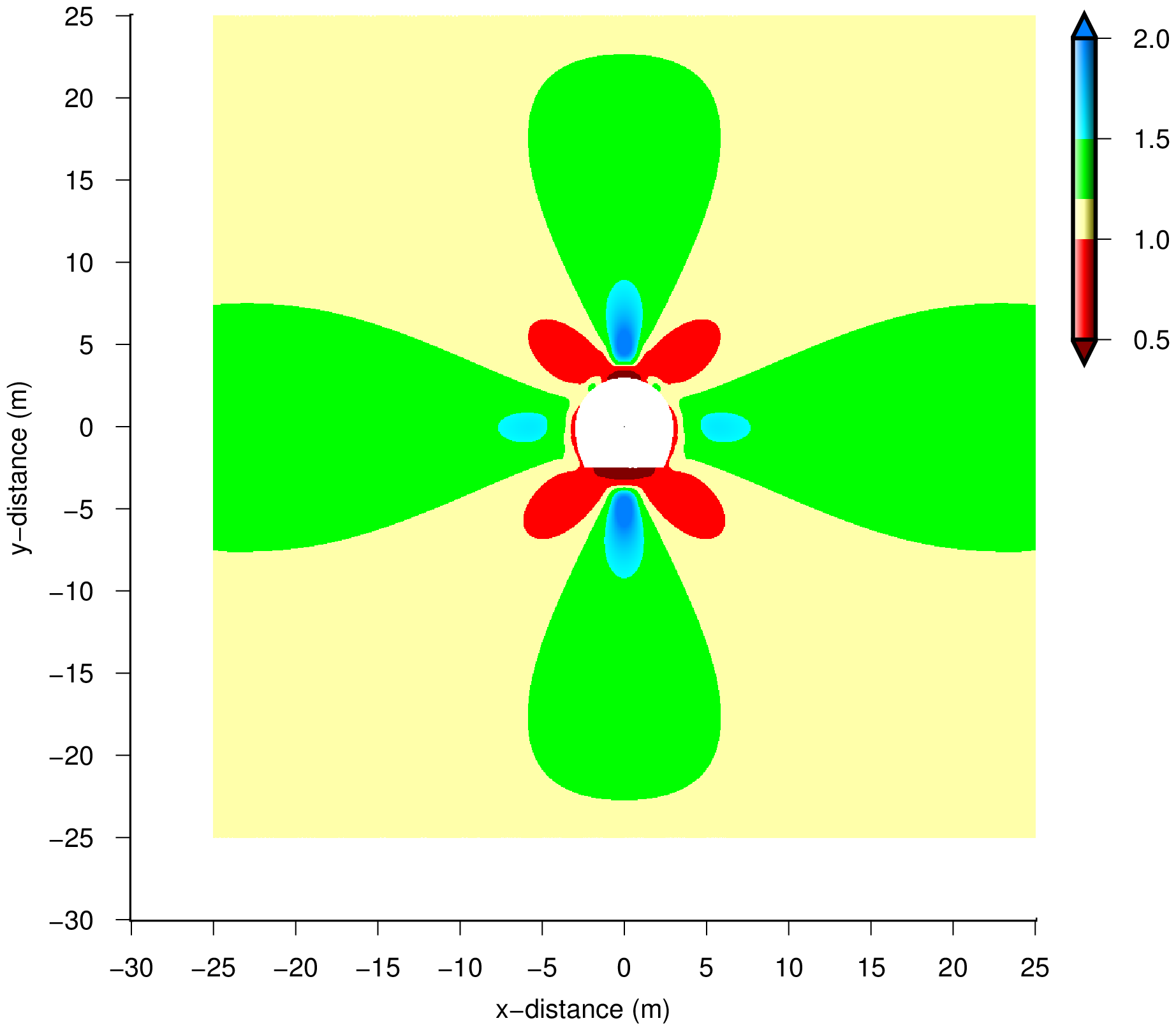 |
| fig_gmt_ps1.png | fig_gmt_ps2.png | fig_gmt_sf.png |
|---|
Arrow diagrams by GMT
 |
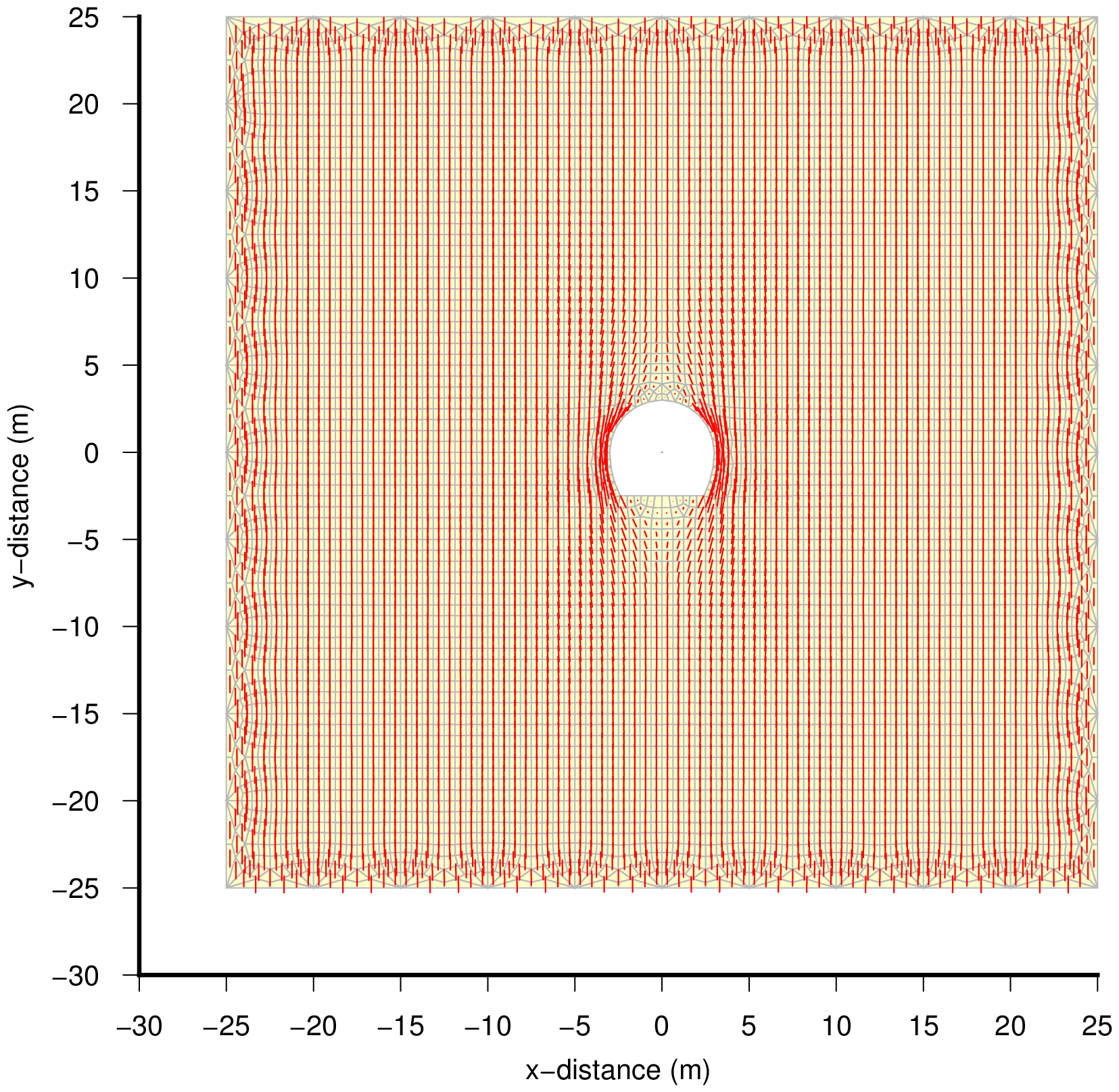 |
| fig_gmt_vec1.png | fig_gmt_vec2.png |
|---|
Contours by Python3
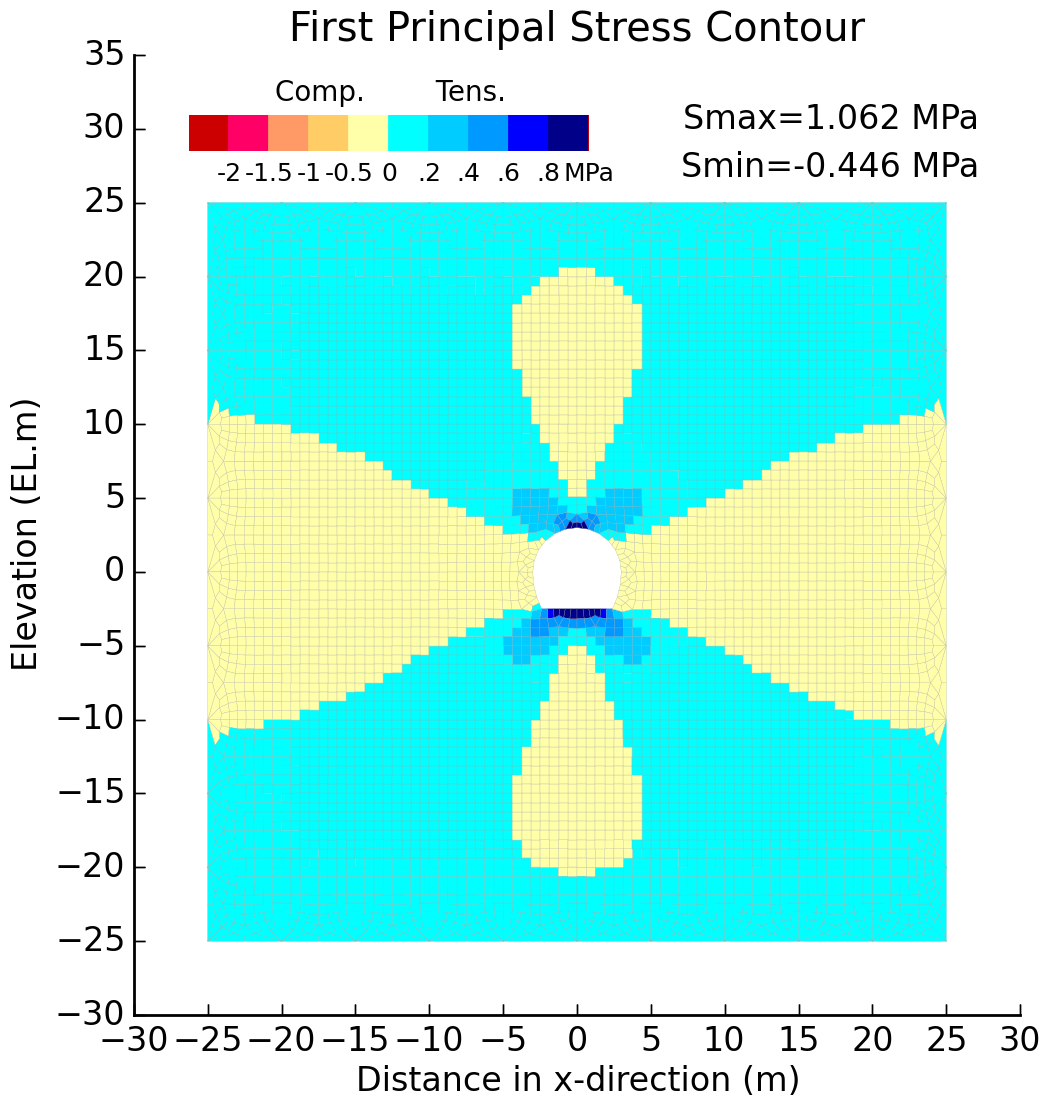 |
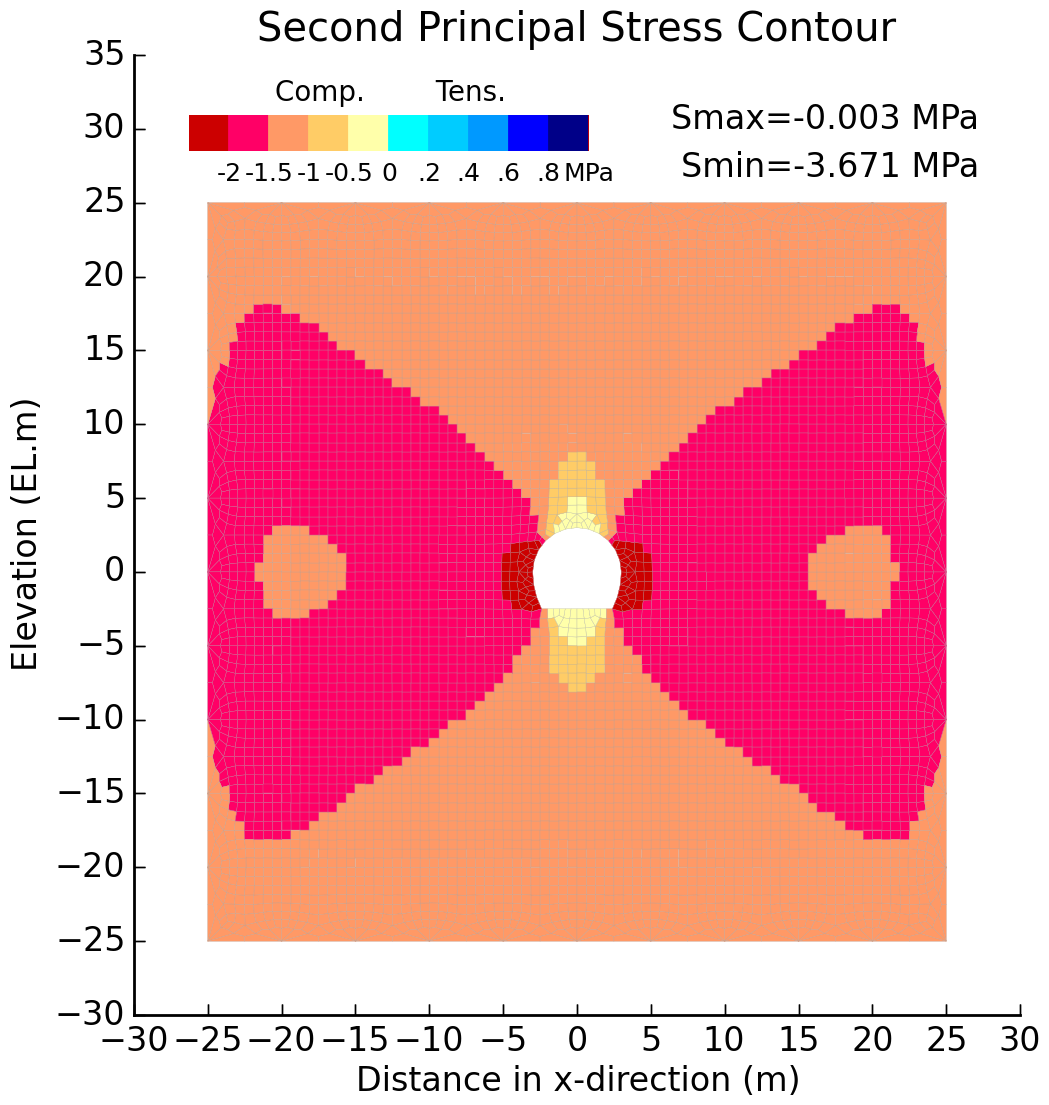 |
 |
| fig_ini4_cont1.png | fig_ini4_cont2.png | fig_ini4_cont3.png |
|---|
Arrow diagrams by Python3
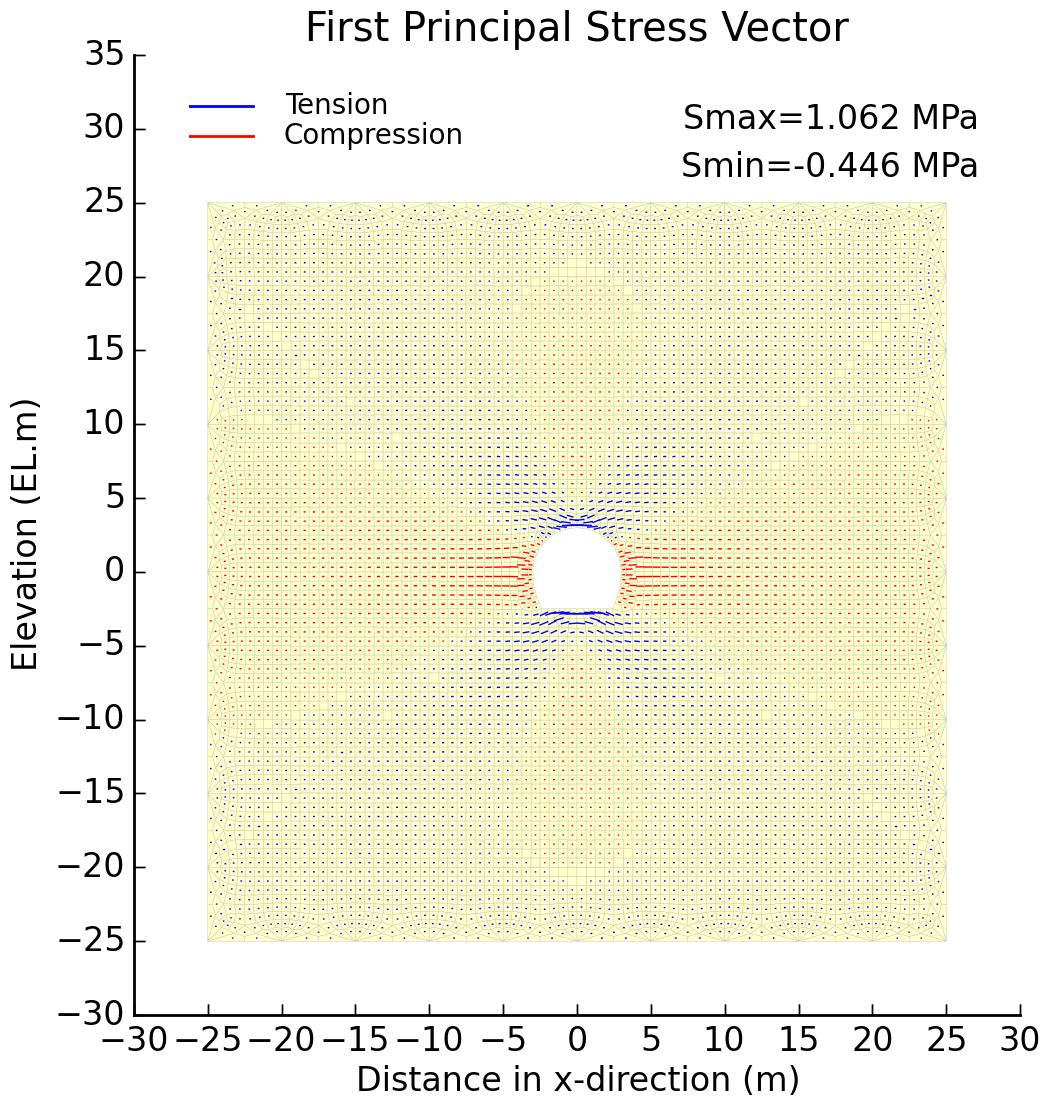 |
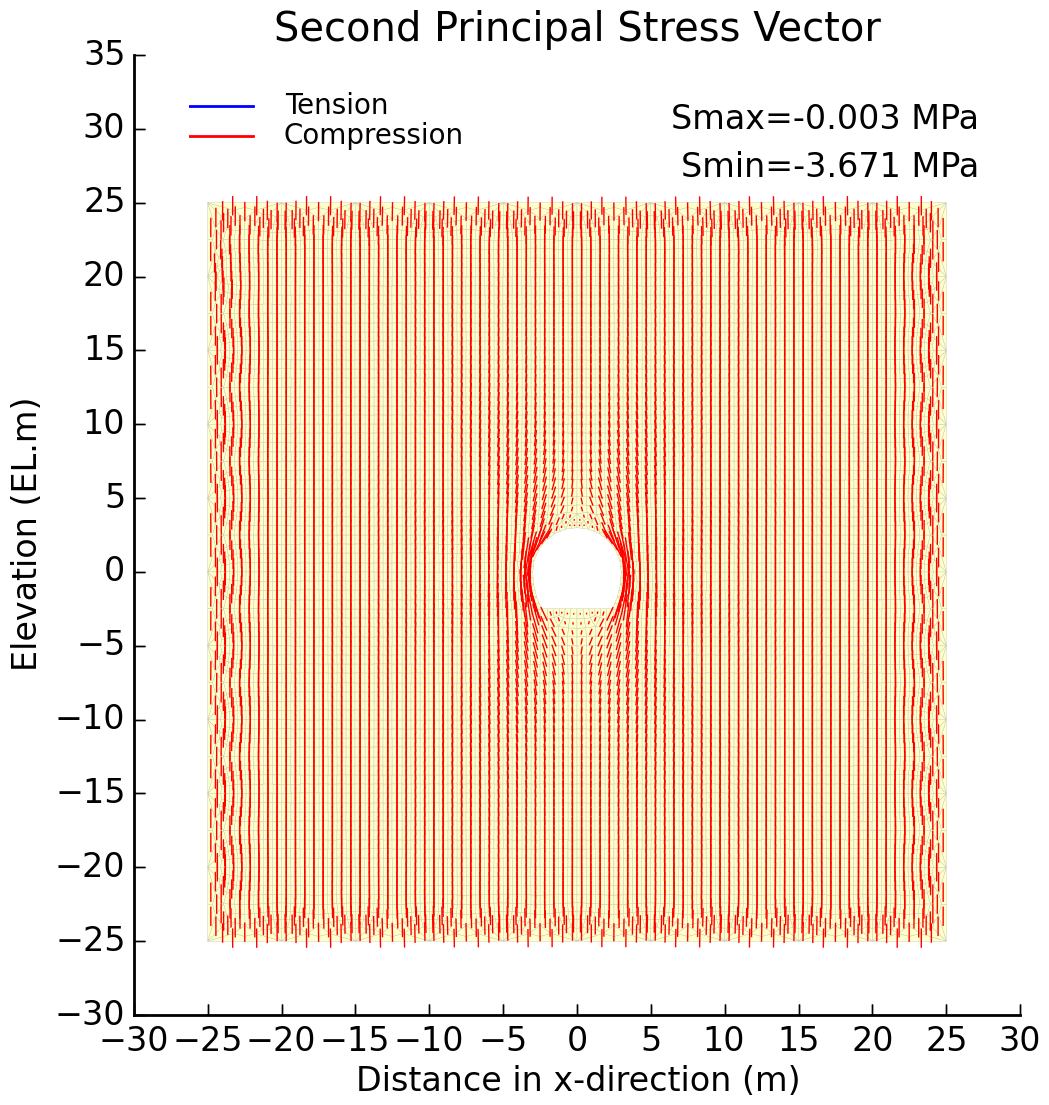 |
| fig_ini4_vect1.png | fig_ini4_vect2.png |
|---|
Programs and sample data
Fortran programs
| Filename | Description |
|---|---|
| f90_fem_ini4.f90 | Tunnel Excavation Analysis |
| f90_gmt_ini4_con.f90 | Drawing using GMT (principal stress and safety factor contour) |
| f90_gmt_ini4_vec.f90 | Drawing using GMT (stress vector arrow diagram) |
| py_fem_ini4_cont.py | Drawing using Python3 (principal stress and safety factor contours) |
| py_fem_ini4_vect.py | Drawing using Python3 (stress vector arrow diagram) |
Usage of Fortran drawing programs
./f90_gmt_ini4_con fnameW.prn ./f90_gmt_ini4_vec fnameW.prn
where, fnameW.prn is output data file by f90_fem_ini4.
| F90 program | Output drawing (fixed name) | Description |
|---|---|---|
| f90_gmt_ini4_con.f90 | _fig_gmt_mesh.eps | Mesh drawing |
| _fig_gmt_ps1.eps | First principal stress contour | |
| _fig_gmt_ps2.eps | Second principal stress contour | |
| _fig_gmt_sf.eps | Safety factor contour | |
| f90_gmt_ini4_vec.f90 | _fig_gmt_vec1.eps | First principal stress arrow diagram |
| _fig_gmt_vec2.eps | Second principal stress arrow diagram | |
| _fig_gmt_disp.eps | Displacement mode |
Usage of Python3 drawing programs
python3 py_fem_ini4_cont.py fnameW.prn python3 py_fem_ini4_vect.py fnameW.prn
where, fnameW.prn is output data file by f90_fem_ini4.
| Python3 program | Output drawing (fixed name) | Description |
|---|---|---|
| py_fem_ini4_cont.py | fig_ini4_cont1.png | First principal stress contour |
| fig_ini4_cont2.png | Second principal stress contour | |
| fig_ini4_cont3.png | Safety factor contour | |
| py_fem_ini4_vect.py | fig_ini4_vect1.png | First principal stress arrow diagram |
| fig_ini4_vect2.png | Second principal stress arrow diagram |
Shell scripts for execution
| Filename | Description |
|---|---|
| a_calc.txt | Calculation |
| a_gmt_con.txt | Principal stress and safety factor contour |
| a_gmt_vec.txt | Stress vector arrow diagram by GMT |
Input data sample
| Filename | Description |
|---|---|
| inp_div_tunnel.csv | inp_div_tunnel.csv |
